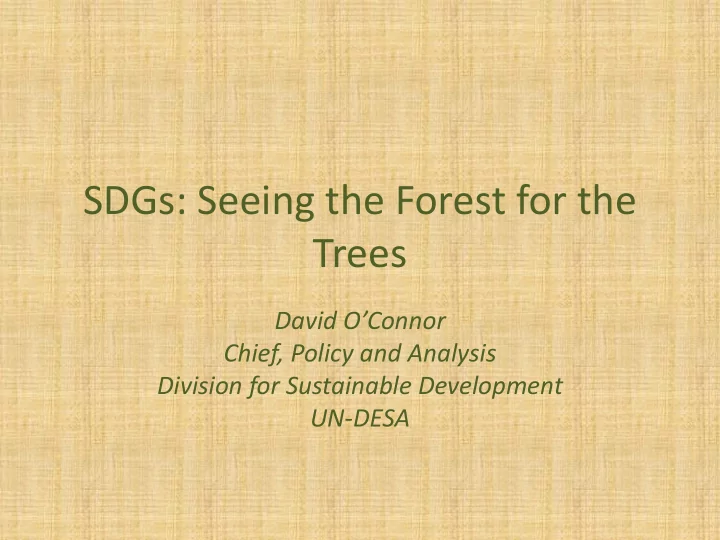

SDGs: Seeing the Forest for the Trees David O’Connor Chief, Policy and Analysis Division for Sustainable Development UN-DESA
SDGs as a linked system Source: David Le Blanc, “Towards Integration at Last? The SDGs as a Network of Targets”, Rio+20 Working Paper 4.
A view from scientists Source: elaboration based on ICSU/ISSC (2015), Review of Targets for the Sustainable Development Goals: A Science Perspective.
Goal 15 Protect, restore and promote sustainable use of terrestrial ecosystems, sustainably manage forests, combat desertification, and halt and reverse land degradation and halt biodiversity loss
OWG Goal 15: targets 1 to 5 15.1 By 2020, ensure the conservation, restoration and sustainable use of terrestrial and inland freshwater ecosystems and their services, in particular forests, wetlands, mountains and drylands, in line with obligations under international agreements 15.2 By 2020, promote the implementation of sustainable management of all types of forests, halt deforestation, restore degraded forests and increase afforestation and reforestation by [x] per cent globally 15.3 By 2020, combat desertification, restore degraded land and soil, including land affected by desertification, drought and floods, and strive to achieve a land-degradation-neutral world 15.4 By 2030, ensure the conservation of mountain ecosystems, including their biodiversity, in order to enhance their capacity to provide benefits that are essential for sustainable development 15.5 Take urgent and significant action to reduce the degradation of natural habitats, halt the loss of biodiversity and, by 2020, protect and prevent the extinction of threatened species
OWG Goal 15: remainder of targets 15.6 Ensure fair and equitable sharing of the benefits arising from the utilization of genetic resources and promote appropriate access to such resources 15.7 Take urgent action to end poaching and trafficking of protected species of flora and fauna and address both demand and supply of illegal wildlife products 15.8 By 2020, introduce measures to prevent the introduction and significantly reduce the impact of invasive alien species on land and water ecosystems and control or eradicate the priority species 15.9 By 2020, integrate ecosystem and biodiversity values into national and local planning, development processes, poverty reduction strategies and accounts 15.a Mobilize and significantly increase financial resources from all sources to conserve and sustainably use biodiversity and ecosystems 15.b Mobilize significant resources from all sources and at all levels to finance sustainable forest management and provide adequate incentives to developing countries to advance such management, including for conservation and reforestation 15.c Enhance global support for efforts to combat poaching and trafficking of protected species, including by increasing the capacity of local communities to pursue sustainable livelihood opportunities
The “forest targets” 6.6 By 2020, protect and restore water-related ecosystems , including mountains, forests , wetlands, rivers, aquifers and lakes … 15.1 By 2020, ensure the conservation, restoration and sustainable use of terrestrial and inland freshwater ecosystems and their services, in particular forests, wetlands, mountains and drylands, in line with obligations under international agreements 15.2 By 2020, promote the implementation of sustainable management of all types of forests , halt deforestation, restore degraded forests and increase afforestation and reforestation by [x] per cent globally … 15.b Mobilize significant resources from all sources and at all levels to finance sustainable forest management and provide adequate incentives to developing countries to advance such management, including for conservation and reforestation
Goal 15: linkages to other goals Source: idem .
Credit, land use, supply chain restrictions help boost yields
Mix of measures Source: D. Nepstad et al., “Slowing Amazon deforestation through public policy and interventions in beef and soy supply chains”, Science, 6 June 2014.
Big but fragile gains “Farmers are frustrated. They are tired of top -down approaches and big UN declarations, and they aren’t seeing price premiums from certifications … . We’ve made great strides, but to lock them in we need to start integrating positive incentives too. We have to help farmers get on the right path.” – Daniel Nepstad, lead author of “ Slowing Amazon deforestation through public policy and interventions in beef and soy supply chains”, Science, 6 June 2014.
Less encouraging trend Source: B.A. Margono et al. (2014), Primary forest cover loss in Indonesia over 2000 – 2012, Nature Climate Change , 4: 730-735.
Recommend
More recommend